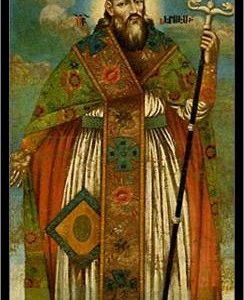As Catholics we are used to hearing one of the psalms read or sung at every Mass. When we do so, we are praying in the same way that Jesus, Mary, the apostles, and the entire Jewish people had for hundreds of years. The Psalms were the hymn book of the Jewish temple. Just as at Mass, each day of the temple’s week had its own psalm used in the daily liturgy. But the Psalms were also part of the Jewish people’s daily prayer, the words that naturally sprang to their lips in trial and triumph—and so we find them on Jesus’s lips in the midst of His Passion (Ps 22: 1; Ps 31:5). The saints have always followed their Lord’s lead, making His prayer their own; and so it was with great joy that this want-to-be-Saint received a copy of Dr. Jim Papandrea’s new book, Praying the Psalms: The Divine Gateway to Lectio Divina and Contemplative Prayer. As I read his dynamic translation, I was again taken aback by the honesty of the Psalms – the longing, pain, faith, and exaltation expressed by their authors; most of all, however, I heard Jesus using these words to express His heart to the Father, and I wanted to do the same. Doctor Papandrea was kind enough to answer some questions for me and Catholic Exchange’s readers.
Shane Kapler: I understand that this work was a multi-year project, one rooted in your own praying of the Psalms. Can you tell readers how it began?
Jim Papandrea: Several years ago I crossed a threshold in my life where I went deeper into prayer, and really stepped up my game, so to speak. One of the things I did was begin to practice Lectio Divina, the ancient practice of praying the words of Sacred Scripture. I prayed through the Psalms, but I had already noticed that there is a lot of material there that is either less conducive to prayer (the psalmists engaging in some self-righteous complaining, or wishing vengeance on their enemies—stuff that we as Christians would not necessarily want to incorporate into our prayers) or a lot of material that is beautiful praise of God, and great for worship; but it’s really talking about God, not talking to God. So I pulled out all the sections from the Psalms where the Psalmist is speaking directly to God, that is, all the lines that we can actually pray and make our own. Then I prayed through all of that, each morning, for a long time. Then I went through it all again, with the Hebrew text in front of me. Then the Greek version—the one Jesus and the Apostles used. And then, finally, the Latin. And when I had done all of that, I had four big notebooks filled with my own translations and notes; and I realized I could put it all together into one new English translation of all of those prayerful excerpts—a translation that took it all into account, and made it really “prayable.”
Kapler: Any time the Bible is translated into English, choices must inevitably be made. Can you say a little bit about your overarching goal in producing this translation and how it guided your decision making (e.g., deciding between the Greek and Hebrew versions of the text, addressing God as “Father”)?
Papandrea: First of all, I want to say that this translation is not meant to replace your favorite Bible, or the text used in liturgy. It’s also not meant to replace the Liturgy of the Hours (Divine Office). It’s meant for your personal prayer time—especially if you’re like I was, and you want to step up your prayer life. And so, to that end, I wanted the translation to feel very applicable to life in the twenty-first century. Whenever you translate from an ancient language into a modern language, you have to make decisions about how much to preserve the poetry and metaphors, versus how much you want to render metaphors and idioms into their modern counterparts. For example, when you read about “the right arm of God” it’s really about God’s power. If you want to retain the beauty of the poetry and the metaphor, you translate it literally: “the right arm of God,” which is what we would hear in the liturgy. But I would choose to translate that as, “the power of God,” which is what it really means. You get right to the meaning without having to think too much about it, or without the risk that you’ll miss the meaning entirely – and that means you can use my translation to compare to your favorite Bible translation if you want help interpreting it. But the trade-off is that you don’t get the poetry of the original. This is why I say that my translation is not meant to replace your favorite Bible, though as I said, it could help you to understand your favorite Bible. My book also includes blank pages for journaling and putting the prayers into your own words. You can write in your own prayers, and keep a journal of your prayers and how they might be answered. In any case, the point is that when you’re in prayer, this translation will more directly connect to your situation and your feelings in the moment, in your everyday life right now. I also included an index to help you find the specific Psalms that apply to your concerns.
Another decision I made was to render the unspeakable divine Name according to the way Jesus taught us to address God. As many people know, one of the names for God in the Old Testament is this word called the “tetragrammaton,” which means four letters in Hebrew (YHVH)—four letters that you’re not supposed to say out loud, out of reverence for God. So if you were reading the text out loud in Hebrew, and you came across the name of God, you’re not supposed to say, “Yahweh,” you’re supposed to swap in the word “Adonai” (the Lord). This is why you often see in your Old Testament the phrase, “The Lord” in small capitals, or set off in some other way to indicate that in the original text, this is the name of God. But for Christians, Jesus is also “the Lord,” so in my translation, whenever I encountered the name of God in the text (YHVH), I did what Jesus told us to do – call God our Father. So rather than swapping in “the Lord” for the tetragrammaton, I translate that as “Father.” This is the Christian substitution for the divine Name when it refers to the First Person of the Trinity. And we know this is a legitimate Christian translation of the text because the Church Fathers believed that before the incarnation of Christ, he popped up in the Old Testament wherever it refers to an appearance of the “angel of the Lord,” which in the Hebrew text is, “the messenger of YHVH” (for example, in Genesis 22:11, 15, and Exodus 3:2). So YHVH is the Father, and his messenger is the Son, Jesus. At least, that’s one way to translate the Psalms for prayer. I knew this might be a controversial decision, and I didn’t make it lightly; but I also knew that I was translating the Psalms for Christian prayer, and so that’s what I chose to do—to follow the example of Jesus, and call God our Father.
Kapler: Like me, I bet many readers have heard lectio divina explained in slightly different ways. Would you give readers an example of how you have used a psalm to practice lectio divina?
Papandrea: Lectio Divina, or “divine reading,” is the practice of praying the words of Scripture. I think that our north American culture of individualism and independence, along with western relativism, have conspired to produce a lot of people who think that their own words are what matter most. But who are we to think that our own words are better for prayer than the words of Sacred Scripture? I’m not saying it’s wrong to pour out your heart to God in prayer; but as St. Paul said, there are times when we don’t know what to say to God, when we don’t have the right words (and I suspect those times are more often than we think). In those times, the Holy Spirit prays in us, and for us (Romans 8:26), and what better way to facilitate that than by praying the words of divine revelation?
So in Lectio Divina we begin by reading Scripture. But we are not reading to “study” Scripture, per se, or even to understand it. We are reading to let it sink in, and see what words jump off the page and speak to our heart. You might think of it this way – rather than pouring your heart out to God, you are letting God pour his words into your heart. So to that end, we read only a little bit—at most a few paragraphs—and we read slowly, very slowly, to really mean every word, and to avoid the temptation to skim over what seems familiar to us. Then, after I read a bit of Scripture I focus on those phrases or words that really seemed relevant in that moment. This does not have to be something that I carry with me beyond today. It’s just for today, like “daily bread.” The next step is to take those words or phrases and meditate on them, which is to say, reflect on them. Again, we are not reading for some timeless interpretation, and it’s definitely not about “what this means to me.” It’s simply about what words or phrases speak to me at that time in my life. I think about what they might have meant in their original context to their original audience, and how my situation might be the same or different. Then I think about how the words might be a prayer to God from me. And then the next step is to pray those words. Don’t embellish or adapt them (yet), just pray them as they are presented in God’s revelation. I pray them over and over again, and as I do that, I boil them down to even fewer words or just a phrase or two. Notice that I’m not adding to them, but reducing them down to their essence, and praying them that way. For example, the whole of Psalm 51 can be boiled down to, “Purify my heart… renew my spirit.” And notice how that fits nicely into two lines that I can pray as I breathe. I pray the first line while breathing in, and the second line while breathing out, repeating the prayer with my breathing. This prevents me from going too fast, as I match the rhythm of my breathing with my prayer. And with breathing prayer, we begin to enter into contemplation. And this is how I pray the Psalms. I explain all this in more detail in a short introduction in the book, but most of the book is simply the excerpts of the Psalms themselves, organized in even numbers of lines, to make breathing prayer easy, if you should choose to pray that way.
Kapler: Tell us a bit more about breathing prayer.” Today, many associate controlled breathing with Hindu and Buddhist meditation. Would you briefly share the history of breathing prayer among Christians?
Papandrea: Breathing prayer was a practice of the early hermits and monks. It’s a way of syncing your body with your spirit, bringing your whole self into the prayer. Although we are spiritual beings, made in the image of God, we are not spirits only – we are embodied; and God made our bodies as an essential part of who we are. In Mass, we worship with our whole selves, including our bodies. We stand to pray, like the early Christians did; and we kneel to express our repentance, again like the early Christians did. We see the lights and liturgical colors, we hear the music, we smell the incense. We taste the sacramental elements. All of our senses are involved.
We can bring our body into our private prayer as well. We can light candles, burn incense, or feel the beads on a rosary. Another way we can include our bodies is by when we match our prayers to our breathing. As I mentioned before, this prevents us from going too fast in our prayers. Matching your prayer to your breathing helps you find the perfect speed, or pace, for your praying. But this is not like the practices of eastern meditation, which often include an attempt to empty the mind—God doesn’t want empty minds. Some versions of non-Christian meditation are meant to take the mind out of the body, as if the body is holding the mind back from its potential; and the goal is to create an altered state of consciousness that numbs the body. We don’t want any of that—we want our bodies and minds in it together. It’s also not like secular “mindfulness” which can be very inward-focused, focused on the self. Christian meditation uses the words of Scripture—not as a mantra that loses the meaning of the words, but as a way of really connecting to God through Jesus Christ, who IS the Word of God (Jn 1:1, 14). Having said that, any practical benefits that eastern or secular meditation may promise, assuming they are truly good for us (like relaxation and enhanced peace), are even more so the byproducts of a deeper prayer life that includes breathing prayer.
In the end, breathing prayer is not a requirement. It is one option for praying the Psalms, and it can lead one into even deeper contemplative prayer. Still, the Psalms can be prayed without matching one’s breathing, and this is especially the case if one prays out loud, as most of the early Christians did. In fact, my book, Praying the Psalms, is meant to be a companion volume to my next book, Praying Like the Early Church, which is coming out in the spring.
Kapler: Thank you, Dr. Papandrea. You obviously put an incredible amount of work into this project; and Praying the Psalms is an amazing gift to the Church. I’ll be looking forward to the sequel!
Photo by Jessica Mangano on Unsplash












